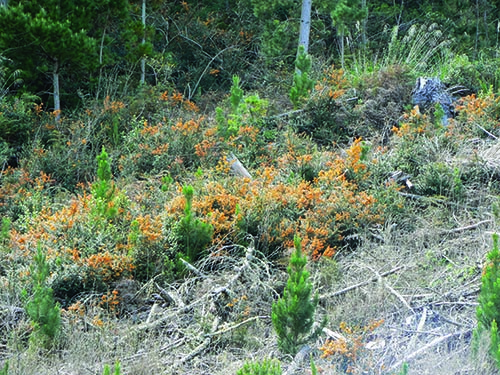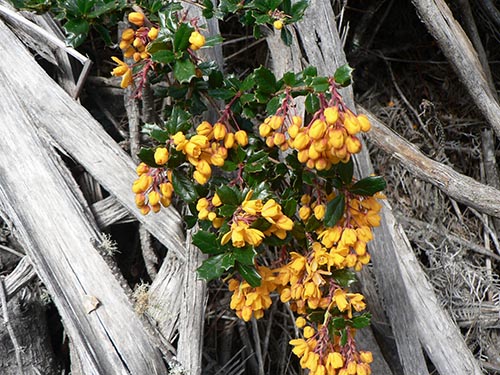| Management programme |
| Progressive containment |
| Objectives |
| Reduce the amount of Darwin’s barberry and limit the locations that have it within the Waikato region. |
| Impacts |
| Economic, biodiversity, social and cultural wellbeing, amenity/recreation |
Darwin’s barberry, a woody evergreen shrub (named after the naturalist, Charles Darwin), is native to southern Chile and Argentina. It’s very invasive in forests, riparian areas and degraded pasture. It’s considered a threat to forestry and native ecosystems. In the Waikato it’s poised to become a serious forestry pest, as without control it will move into farmland and areas of indigenous forest.

What does it look like?
Darwin’s barberry is a woody, evergreen shrub that grows to between 4m-5m tall.
Flowers
- Hanging clusters (racemes) of yellow-orange flowers (each 5mm-6mm diameter).
- Flowers from July to February.
Fruit/seeds
- Clusters of oval dark purple to black berries on red stalks.
- Each berry is between 5mm-7mm.
- Berries have a bluish-white waxy bloom.
Leaves/stems
- Leaves are stiff, dark green and glossy.
- Leaves are about 3cm long, with 3-5 spiny tips.
- There are five short spines below each group of leaves.
- Stems are tough, woody and densely hairy with five-pronged, needle-sharp spines.
Similar plants
All Berberis species present in New Zealand have been introduced, mainly for use as ornamental or hedge plants. European barberry (Berberis vulgaris) is deciduous and has red berries. Berberis souliena and Mrs Wilson’s barberry (Berberis wilsonae) are both cultivated; the former grows to 2m with hairless stems and black fruit, the latter is deciduous and has pink fruit. Barberry (Berberis glaucocarpa) has paler yellow flowers, less glossy leaves and at 7m is taller than other Berberis species present in New Zealand.
.
Why is it a pest?

Darwin’s barberry grows in scrub, forests, plantation margins and roadside. It tolerates moderate to cold temperatures, damp to dry conditions, high wind, salt, shade, physical damage, grazing (not browsed), and a range of soil types. While it occasionally spreads by soil and water movement, it’s primarily spread via seed. It fruits earlier in summer than many other species (both native and exotic) and the large quantities of seed it produces are dispersed widely by birds and other vertebrates such as possums. It can also regenerate via root suckers and layering.
Darwin’s barberry is poised to become a serious forestry pest. Dense infestations near the Waikato region include Rainbow Mountain near Rotorua, within exotic forest in the Bay of Plenty region and the entire Kaingaroa Forest. There are also significant patches in the Manawatu-Wanganui region, southwest of Pureora Forest.
Control methods
Physical control
Smaller plants can be grubbed out. Leave on site to rot down (all year round). Cut stumps resprout quickly and can be hard to kill and seeds will germinate onto bare land. Follow up six monthly.
Herbicide control
Basal treatment of trunk
Apply with a low pressure sprayer using solid cone nozzle or a paintbrush. Liberally treat the full circumference and the basal parts of the shrub or tree trunks in a manner that thoroughly wets at least 2 to 3 times the diameter of the lower stem or trunk including the root collar area.
Cut stump treatment
Cut the plant down, leaving a stump no higher than 5cm above ground level. Paint herbicide immediately over the entire stump surface, including the sides.
Frilling
Make shallow downward cuts around the trunk and near the ground using a machete or axe. Cuts should overlap to effectively ringbark the tree. Apply herbicide immediately to the point of runoff into each cut.
Spray application
Most suitable for smaller plants, but pulling out plants by hand may be cheaper and easier. Total coverage of leaf surfaces is required for effective control.
Safety when using herbicides
- Follow the instructions on the manufacturer’s label.
- Always wear protective clothing.
- Always minimise the risk to your other plants.
- Contact the supplier for further advice.
Disclaimer: Any product names mentioned below are not an endorsement nor are they a criticism of similar products not mentioned.
Summary of herbicides and application methods for control
| Herbicide | Application |
| X-Tree Basal® | Basal treatment of trunk (all year round). |
| Glyphosate or metsulfuron or picloram gel or triclopyr/picloram mix or triclopyr | Stump swab (all year round), frilling. |
| Metsulfuron | Cut and inject (all year round), frilling. |
| Metsulfuron or triclopyr/picloram mix | Spray (spring to autumn). |
| Herbicide rules will apply. You may need to notify neighbours if spraying. The Waikato Regional Plan explains the agrichemical (herbicides) use rule in section 6.2 | |
More information
Advice
- For advice and additional information on control methods, call our pest plant staff on freephone 0800 800 401.
- Chemical company representatives, farm supply stores, garden centres or the Weedbusters website can also be good sources for advice.
Publications
The following publications are available for download or from Waikato Regional Council. Contact us to request a copy (freephone 0800 800 401).






To ask for help or report a problem, contact us
Tell us how we can improve the information on this page. (optional)